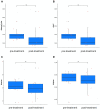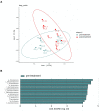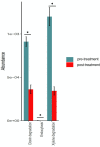Changes of Gut Microbiome in Adolescent Patients with Chronic Spontaneous Urticaria After Omalizumab Treatment
- PMID: 36762258
- PMCID: PMC9907007
- DOI: 10.2147/CCID.S393406
Changes of Gut Microbiome in Adolescent Patients with Chronic Spontaneous Urticaria After Omalizumab Treatment
Abstract
Purpose: Omalizumab is a humanized anti-immunoglobulin (Ig) E monoclonal antibody that is effective in treating some patients with chronic spontaneous urticaria (CSU) who do not respond to antihistamines. Gut microbiome plays a role in the pathogenesis of allergies and autoimmune diseases. Here, we investigated differences in the gut microbiome of adolescent CSU patients before and after omalizumab treatment, which has not been previously reported.
Patients and methods: Ten adolescent CSU patients were given 300 mg omalizumab subcutaneously in three treatments at 4-week intervals. Urticaria Activity Score (UAS7) was applied to evaluate the efficacy of each omalizumab treatment during follow-up. Fecal samples were collected before and 12 weeks after the first treatment. Total DNA of the gut microbiota in all fecal samples were extracted. The 16S rRNA gene-targeted sequencing technology was used for the analysis of the diversity and distribution of gut microbiome, followed by bioinformatics analysis.
Results: UAS7 scores decreased significantly after each treatment compared with the baseline (all P < 0.0001). There were five well-controlled responders and five non-responders after three treatment sessions of omalizumab. The dominant bacteria phyla in all fecal samples were Firmicutes, Bacteroidetes, Proteobacteria, and Actinobacteria. Alpha diversity analysis showed no significant difference before and after treatment (P > 0.05), whereas beta diversity analysis revealed a significant difference in the bacterial abundance before and after treatment (P < 0.01). The relative abundance of Alphaproteobacteria and Betaproteobacteria at the class level and Burkholderia, Rhodococcus, and Sphingomonas at the genus level decreased significantly after treatment (linear discriminant analysis > 4, P < 0.05). The functional prediction results showed that the dioxin and xylene degradation pathways were more abundant before treatment.
Conclusion: Omalizumab is effective in treating CSU and the abundance of Alphaproteobacteria and Betaproteobacteria was reduced after treatment, which may help improve the treatment outcomes in adolescent CSU patients.
Keywords: 16S rRNA gene-targeted sequencing; adolescent patients; chronic spontaneous urticaria; gut microbiome; omalizumab.
© 2023 Wang et al.
Conflict of interest statement
Authors declare no competing interests for this study.
Figures







Similar articles
-
Abnormalities in Gut Microbiota and Metabolism in Patients With Chronic Spontaneous Urticaria.Front Immunol. 2021 Oct 15;12:691304. doi: 10.3389/fimmu.2021.691304. eCollection 2021. Front Immunol. 2021. PMID: 34721374 Free PMC article.
-
Omalizumab on Chronic Spontaneous Urticaria and Chronic Inducible Urticaria: A Real-World Study of Efficacy and Predictors of Treatment Outcome.J Korean Med Sci. 2022 Jul 11;37(27):e211. doi: 10.3346/jkms.2022.37.e211. J Korean Med Sci. 2022. PMID: 35818702 Free PMC article.
-
Gut Microbiome Alterations and Functional Prediction in Chronic Spontaneous Urticaria Patients.J Microbiol Biotechnol. 2021 May 28;31(5):747-755. doi: 10.4014/jmb.2012.12022. J Microbiol Biotechnol. 2021. PMID: 33746191 Free PMC article.
-
Expert opinion: defining response to omalizumab in patients with chronic spontaneous urticaria.Eur J Dermatol. 2017 Oct 1;27(5):455-463. doi: 10.1684/ejd.2017.3085. Eur J Dermatol. 2017. PMID: 29084635
-
Omalizumab for treating chronic spontaneous urticaria: an expert review on efficacy and safety.Expert Opin Biol Ther. 2017 Mar;17(3):375-385. doi: 10.1080/14712598.2017.1285903. Epub 2017 Feb 9. Expert Opin Biol Ther. 2017. PMID: 28125304 Review.
Cited by
-
Current insights on gut microbiome and chronic urticaria: progress in the pathogenesis and opportunities for novel therapeutic approaches.Gut Microbes. 2024 Jan-Dec;16(1):2382774. doi: 10.1080/19490976.2024.2382774. Epub 2024 Jul 30. Gut Microbes. 2024. PMID: 39078229 Free PMC article. Review.
References
-
- Kulthanan K, Tuchinda P, Chularojanamontri L, et al. Clinical practice guideline for diagnosis and management of urticaria. Asian Pac J Allergy Immunol. 2016;34(3):190–200. - PubMed
LinkOut - more resources
Full Text Sources

